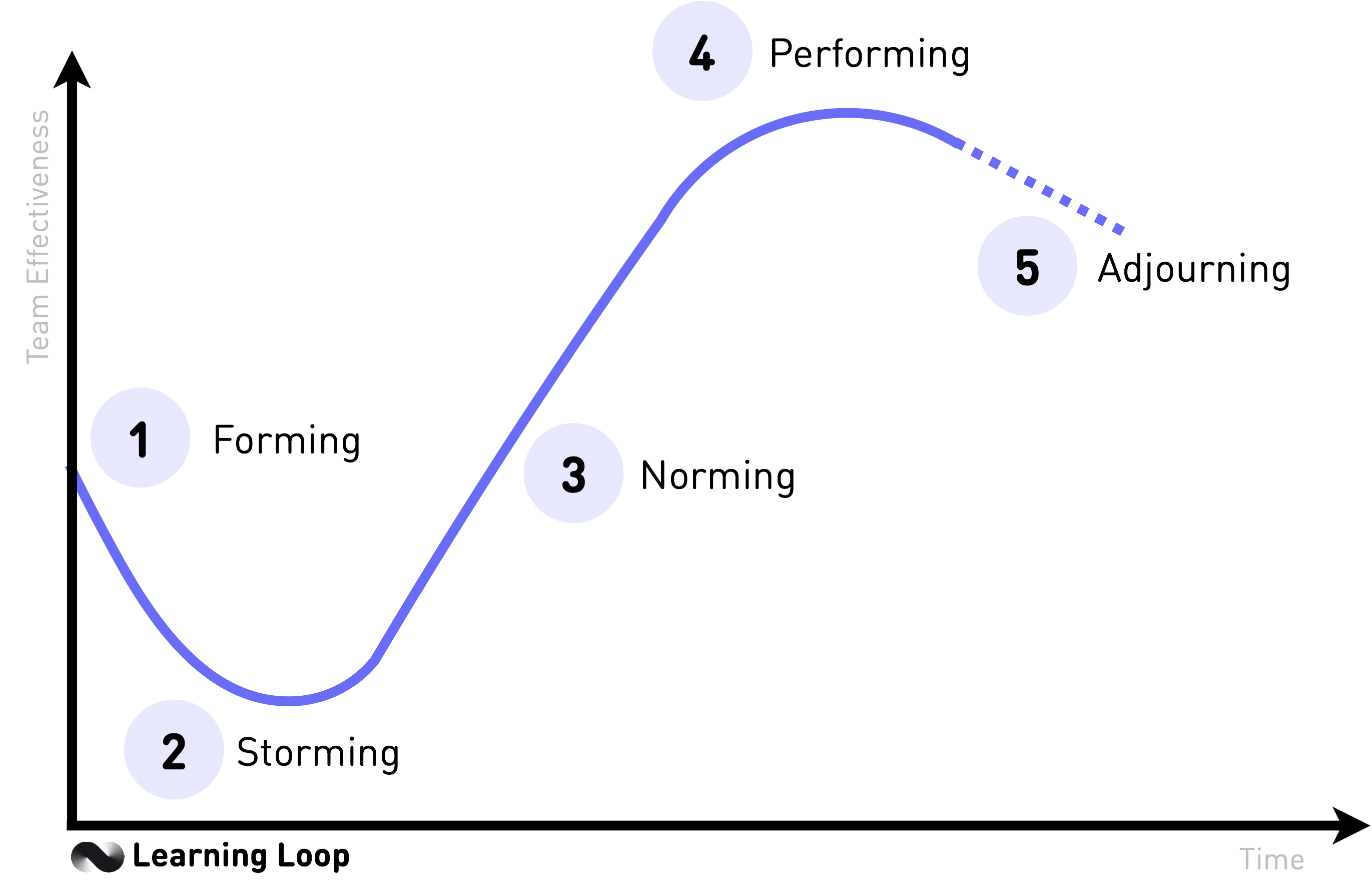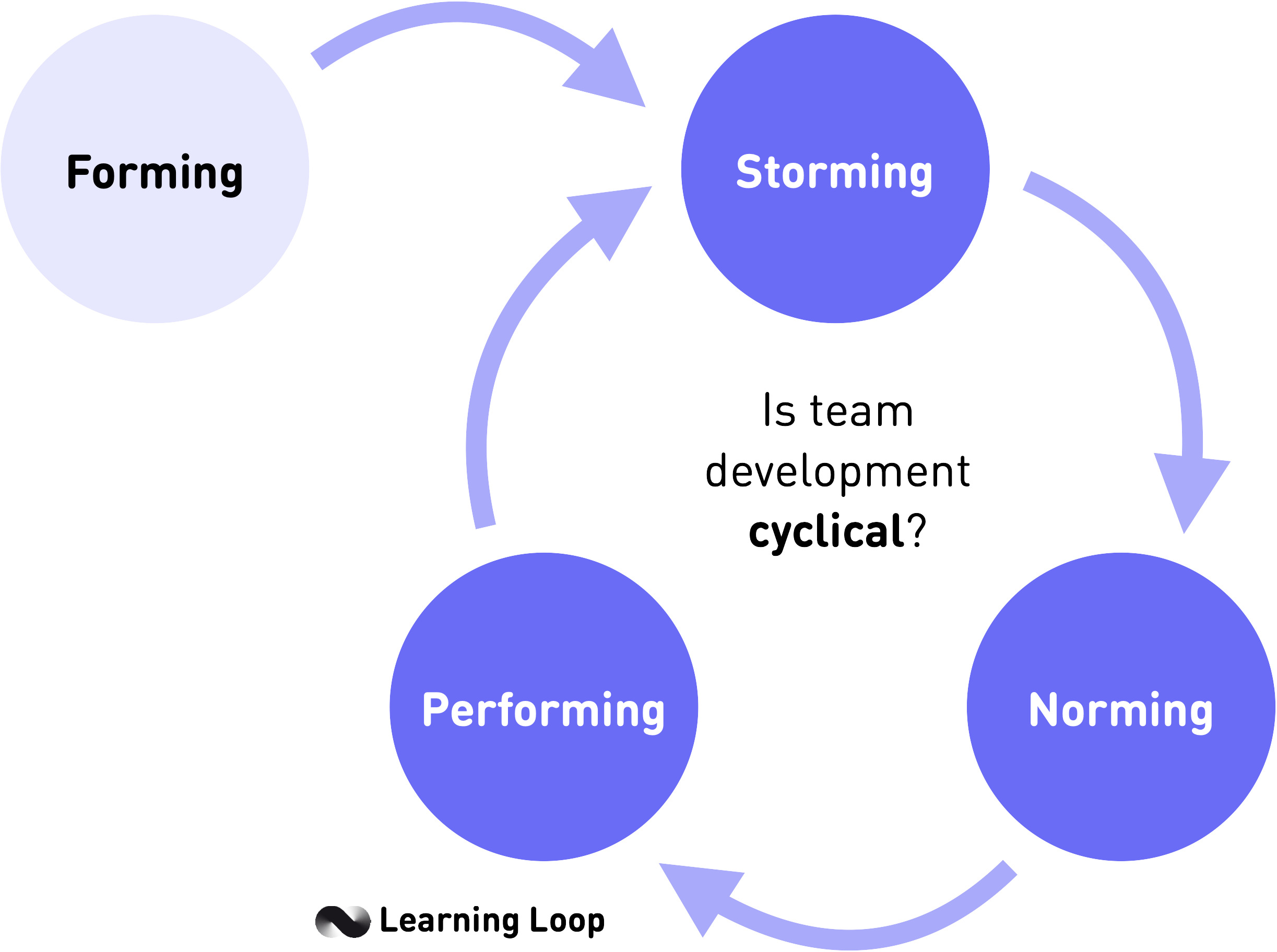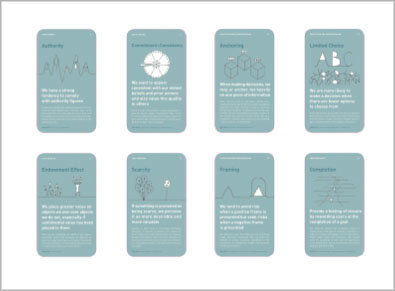Leadership, Product management, Organizational psychology, Agile coaching
Tuckman’s Team Stages
Understand how teams evolve, resolve conflict, and grow into high-performing teams.
Also called: Tuckman model, Tuckman ladder, Forming-Storming-Norming-Performing, Stages of group development, and Team development stages
See also: Circles of Influence, Circles of Influence, Definition of Done
Relevant metrics: Sprint-to-sprint velocity stability, Average cycle-time trend, Number of unresolved impediments per sprint, Escaped defects per release, Team satisfaction score, Voluntary attrition, and Team member eNPS (engagement score)
What does Tuckman’s theory explain about turning a group into a team?
Tuckman’s Team Stages is a team development model that describes the predictable phases a group travels through on its way to high performance. The five stages are:
- Forming – team members come together, seek purpose, and rely on a leader for direction.
- Storming – roles and approaches clash; conflict surfaces around ways of working.
- Norming – agreements on norms, tools, and processes reduce friction; trust grows.
- Performing – the group works interdependently toward shared goals with minimal friction.
- Adjourning – work concludes; the group disbands and reflects on learning.

The model shows that conflict (storming) is not a sign of failure but a natural step toward performance.
Where did the five stages of group dynamics originate and what are they?
Bruce W. Tuckman, then a doctoral candidate at Princeton University, reviewed fifty studies on small‑group development and summarised common patterns in the 1965 article “Developmental Sequence in Small Groups” (Psychological Bulletin, 63 (6)). He outlined four stages centred on interpersonal relations and task activity.
In 1977, Tuckman and Mary Ann Jensen revisited the model in “Stages of Small‑Group Development Revisited” (Group & Organization Studies, 2 (4)) and added a fifth phase, Adjourning, to capture the closure of temporary teams.
The model spread quickly because practitioners recognised its fit with classroom, military, and project settings. It is now a staple reference in organisational psychology, education, and agile coaching.
What is the difference between a group and a team?
A group is a collection of people who happen to work together. A team adds shared goals, interdependence, and joint accountability. Tuckman’s model explains the steps a group takes to become a true team.
How do teams progress through the 5 stages of Tuckman’s team development model?
1. Forming
The first stage centres on orientation and reassurance. People join the group, note titles and background, and seek confirmation that the assignment is worthwhile and safe.
Participants are generally optimistic but cautious. They wonder how they will fit in, which skills matter, and whether it is acceptable to ask basic questions.
Discussion is courteous and non‑confrontational. Much time is spent on introductions, tool access, and clarification of work hours or communication channels. Few volunteers step forward to challenge ideas.
As a leader, your goal in this stage is to facilitate a shared understanding of the product vision, scope, and constraints, then agree on simple ground rules that cover meeting cadence, decision style, and preferred tools. To learn how to best work together using those ground rules, consider forming the mission of delivering at least one thin vertical slice end‑to‑end to demonstrate the delivery workflow.
In an agile team setting, defining ways of working in a working agreement and agreeing in a shared Definition of Done are common practices.
2. Storming – the “Valley of Despair”
The honeymoon ends and underlying differences surface. Conflicting priorities, diverse work histories, and ambiguous roles converge, creating turbulence often called the Valley of Despair. Morale dips while the team diverts energy from delivery to relationship‑building and norm‑finding.
The Storming phase is not always bad for success
Anxiety and frustration replace the cautious optimism of Forming. Some members fear being judged; others worry goals are unattainable. The tension is necessary. Conflict produces the data that later supports high performance, but it feels uncomfortable in the moment.
You know you’re in the Storming phase when meetings run long. Estimates are challenged and assumptions questioned. Side conversations multiply on chat channels. Politeness fades; a sharp tone or eye‑roll may surface. Metrics tell the same story: velocity dips, cycle time lengthens, and the burndown flattens.
Other signals include:
- Personalising conflict. Team members attack people instead of problems.
- Decision paralysis. Fear of choosing the wrong path delays delivery.
- Hidden factions. Sub‑groups discuss grievances offline, eroding psychological safety.
As a leader, your job is to bring disagreements into the open and attach them to facts, not personalities. Clarify and, if needed, renegotiate scope, roles, and success criteria. You might consider practising structured conflict handling to build confidence in collaborative problem‑solving.
The servant leader becomes a conflict facilitator, modelling neutrality and curiosity. The Product Manager sharpens prioritisation so debates focus on the most valuable work. Leaders affirm that conflict is expected and useful, celebrating progress on interpersonal issues as much as progress on code.
Consider using:
- Time‑boxed retrospectives that focus on a single tension point.
- Working‑agreement rewrites to tighten the Definition of Done or pair‑programming rules.
- Spike stories—short research tasks that gather data to resolve technical disputes.
- Ladder of inference or “five‑whys” exercises to separate emotion from evidence.
Storming gives way to Norming when debates shift from who is right to what will work, burn‑down charts resume a downward slope, and humour reappears—even about past conflicts—indicating psychological safety has improved.
3. Norming
You know you have reached the Normign phase when agreement replaces argument. After the turbulence of Storming, the team begins to settle into productive patterns and a sense of shared identity emerges.
Confidence grows as commitments are met. Members feel comfortable voicing ideas and admitting mistakes, trusting that the group will respond constructively. A low‑level pride in belonging develops alongside curiosity about improving the workflow.s
Communication becomes open and efficient. Peer reviews are offered without defensiveness, and knowledge sharing sessions arise organically. Metrics stabilise: velocity variance narrows, cycle time shortens, and escaped defects decline. Humour returns, signalling psychological safety.
This is a time to strengthen shared norms so that collaboration will be smooth – even under pressure. Make sure to spread critical knowledge to remove single points of failure. This is also a time where your team can begin being systematic and data-driven about what improvement experiments they take on.
Consider:
- Role rotation (e.g., developer pairs with tester) to broaden expertise.
- Working‑agreement reviews each retrospective, fine‑tuning norms as context shifts.
- Metrics review sessions where the team correlates delivery data with process tweaks.
- Communities of practice across squads to exchange approaches and tools.
Norming transitions to Performing when the team proposes improvements without prompting, self‑organises to meet sprint goals, and resolves most impediments internally before escalating. A sustained trend of predictable delivery and constructive peer challenge indicates readiness for high performance.
4. Performing
With norms embedded and trust high, the team behaves as a single, self‑directed system. Decisions happen where the work happens, impediments are tackled before they grow, and energy is channelled into maximising customer value rather than negotiating roles or process.
When a team is performing, decisions happen where the work happens.
A quiet confidence prevails. Members feel safe suggesting bold ideas or pointing out flaws because past experience shows the group will respond constructively. Pride in workmanship and ownership of outcomes replace earlier concerns about individual status.
When a team is performing you will see code reviews, testing, documentation, and deployment are being integrated and are continuous. Roles are fluid: a developer writes an automated test, a tester improves a build script, a designer leads story‑mapping. Sprint reviews focus on learning from customer feedback, not just showing completed scope. Key delivery metrics—lead time, escaped defects, sprint‑goal success—plateau at healthy levels.
Your job as a leader is to help the team to continue deliver a steady stream of customer value at a sustainable pace. Make learning visible through improvement or learning backlogs – from technical, process, and business angles.
The leader focuses on shielding the team from shifting priorities, facilitating access to stakeholders, and ensuring time for skills growth. The focus is on outcome over output. Decision authority rests with those closest to the work.
Psychological safety must be refreshed, not assumed. Regular retrospectives remain essential but shift focus toward anticipatory improvements rather than problem fixing. Periodic lightweight health checks, cross‑team knowledge exchanges, and short off‑sites strengthen cohesion and creativity. Technical debt is tracked openly and addressed in small, continuous slices to avoid sudden slow‑downs.
Watch for rising cycle time variance, increased work‑in‑progress, or a resurgence of unspoken conflict—signals that stress or change is nudging the team back toward Storming. Early acknowledgement and facilitation prevent extended back‑sliding.
5. Adjourning
A time might come where your project finishes or priorities shift. Teams disband. Although delivery work tapers off, the final stage demands deliberate effort to preserve knowledge, honour contribution, and ease the transition to new assignments.
Satisfaction, relief, and nostalgia blend with uncertainty about future roles. Some members move on mentally before the last release; others cling to familiar rituals. Emotional divergence can create a brief spike in misunderstandings if not acknowledged.
Velocity becomes erratic as engineers juggle finishing touches with hand‑over documentation. Attendance at routine ceremonies may drop, replaced by short ad‑hoc syncs focused on closure tasks. Conversations turn retrospective, revisiting decisions and milestones.
Make sure to close down in a responsible manner. Close all open deliverables and technical debt items that threaten maintainability.Capture explicit and tacit knowledge so future teams can extend or support the product and most importantly: Provide a sense of closure through reflection and recognition.
You might consider facilitating a final retrospective or mapping what knowledge is more important to transfer to incoming owners.
Even small gestures—team lunch, slide deck of achievements, or thank‑you round in the final stand‑up—strengthen positive memory and future collaboration. Public recognition in a company channel signals organisational appreciation.
Adjourning is complete when stakeholders confirm acceptance of final deliverables, knowledge repositories pass an agreed review checklist, and all members have clear next assignments or onboarding plans. Only then does the team fully disband and individuals re‑enter Forming in new contexts.
Critiques and disadvantages of the Tuckman Model
While Tuckman’s model has become one of the most cited frameworks for understanding group development, it is not without criticism. Educators and researchers have pointed out limitations that are especially relevant to complex or long-term team environments.
Is team development cyclical rather than linar?
One of the most common critiques is that the model assumes a linear and sequential path from Forming to Adjourning. In practice, teams often cycle back to earlier stages—especially Storming—when new members join, scope changes dramatically, or external pressure mounts. Real-world development is often more recursive than linear.

Underemphasis on task complexity
Tuckman’s original research was based on studies of therapy, training, and educational groups, which often had well-defined tasks and short durations. Agile and product teams, by contrast, operate in complex environments with evolving goals, ambiguous information, and continuous discovery. The model does not account for how those variables affect team development.
Norming as conformity
Critics also argue that “Norming” can be mistaken for unhealthy conformity, where dissent is suppressed in the name of harmony. Without safeguards, a team can mistake peace for progress and avoid necessary conflict, stalling learning and innovation.
Overshadowing alternative models
Because of its popularity, Tuckman’s model often overshadows other frameworks that incorporate cognitive, emotional, or environmental factors, such as the Hackman Model of Team Effectiveness or Lencioni’s Five Dysfunctions of a Team. These alternatives may offer richer insight in complex or dysfunctional team contexts.
Despite these critiques, many practitioners still find Tuckman’s model useful as a shared baseline vocabulary. When used with awareness of its boundaries—and supplemented by other perspectives—it remains a helpful lens for diagnosing team dynamics and facilitating progress.
-
What does Tuckman's theory explain?
Hint It describes how a group of individuals becomes an interdependent, accountable and high-performing team through five sequential stages. -
What are the 5 stages of Tuckman's development?
Hint Forming, Storming, Norming, Performing and Adjourning. -
How to move from storming to norming?
Hint Make conflict explicit, link debate to data, agree on working agreements and run small trust-building experiments. -
How do you overcome the storming stage?
Hint Use time-boxed retrospectives, neutral facilitation, clear prioritisation and evidence-gathering spikes to convert tension into learning. -
What does norming look like?
Hint Open communication, consistent commitments met, and team-initiated improvements with stable delivery metrics. -
Why is the norming stage important?
Hint It hard-wires collaborative habits that let the team maintain performance under pressure. -
What should a leader do in the storming stage?
Hint Facilitate neutrally, keep vision clear, model curiosity and normalise productive disagreement. -
Is the storming stage always bad for group success?
Hint No. Properly managed conflict creates the shared understanding required for later high performance. -
What is the conflict in the storming stage?
Hint Clashing priorities, unclear roles and different working styles surface when politeness gives way to honest debate.
